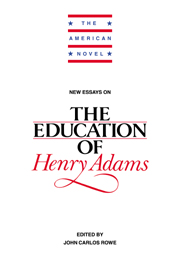Book contents
- Frontmatter
- Contents
- Series Editor's Preface
- 1 Introduction
- 2 The Education of an American Classic: The Survival of Failure
- 3 Being a “Begonia” in a Man's World
- 4 Henry Adams's Education in the Age of Imperialism
- 5 The Education and the Salvation of History
- Notes on Contributors
- Selected Bibliography
- Index
4 - Henry Adams's Education in the Age of Imperialism
Published online by Cambridge University Press: 15 December 2009
- Frontmatter
- Contents
- Series Editor's Preface
- 1 Introduction
- 2 The Education of an American Classic: The Survival of Failure
- 3 Being a “Begonia” in a Man's World
- 4 Henry Adams's Education in the Age of Imperialism
- 5 The Education and the Salvation of History
- Notes on Contributors
- Selected Bibliography
- Index
Summary
He had nothing to do with Hay's politics at home or abroad.
–The Education of Henry Adams, ch. 24, p. 366.With Hay's politics, at home or abroad, Adams had nothing whatever to do.
–The Education of Henry Adams, ch. 24, p. 373.I have always been baffled by the final one hundred fifty pages of Henry Adams's Education, from chapter 24, “Indian Summer,” to chapter 35, “Nunc Age.” The world history Adams recounts from the Spanish-American War in 1898 to the Russo-Japanese War of 1904–1905 is, of course, enormously complicated. With his penchant for finding chaos everywhere and ignorance in everyone, not least in himself, Adams wants to confuse the reader further. In a more generous vein, I might suggest that these chapters rhetorically simulate the kind of confusion experienced by a knowledgeable political observer faced with world events at the turn of the century. Confusing as those world events were, Adams makes them even more incomprehensible by digressing at crucial moments into philosophical speculations, tirades against the “New Woman,” and sardonic judgments of the personalities of such major political figures as Teddy Roosevelt, Lord Pauncefote, Cassini, John Hay, and the Kaiser. Scholars and critics have labored over these pages in efforts to do justice to the coherence of Adams's prose, often developing elaborate connections among “The Dynamo and the Virgin,” “A Dynamic Theory of History,” and the international politics described.
- Type
- Chapter
- Information
- New Essays on The Education of Henry Adams , pp. 87 - 114Publisher: Cambridge University PressPrint publication year: 1996



